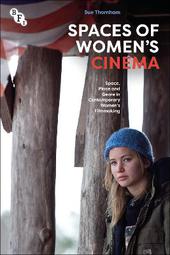
|
Spaces of Women's Cinema: Space, Place and Genre in Contemporary Women's Filmmaking
Paperback / softback
Main Details
| Title |
Spaces of Women's Cinema: Space, Place and Genre in Contemporary Women's Filmmaking
|
| Authors and Contributors |
By (author) Sue Thornham
|
| Physical Properties |
| Format:Paperback / softback | | Pages:240 | | Dimensions(mm): Height 234,Width 156 |
|
| Category/Genre | Films and cinema |
|---|
| ISBN/Barcode |
9781844579112
|
| Classifications | Dewey:791.43/095 |
|---|
| Audience | | Tertiary Education (US: College) | |
|---|
| Illustrations |
31 bw illus
|
|
Publishing Details |
| Publisher |
Bloomsbury Publishing PLC
|
| Imprint |
BFI Publishing
|
| Publication Date |
21 March 2019 |
| Publication Country |
United Kingdom
|
Description
Sue Thornham explores issues of space, place, time and gender in feminist filmmaking through an examination of a wide range of films by contemporary women filmmakers, ranging from the avant-garde to mainstream Hollywood. Beginning from questions about space itself and the way it has been gendered, she asks how representation functions in relation to space and time, and how this, too, is gendered, before moving to an exploration of how such questions might be considered in relation to women's filmmaking. In sections dealing with spaces from wilderness to city, she analyses in detail how these issues have been dealt with by women filmmakers, addressing the work of filmmakers such as Jane Campion, Kathryn Bigelow, Julie Dash, Maggie Greenwald, Patricia Rozema and Carol Morley, and films including 'An Angel at My Table' (1990), 'Daughters of the Dust' (1991) 'The Ballad of Little Jo' (1993), 'Winter's Bone' (2010), 'Zero Dark Thirty' (2012) and 'The Falling' (2014).
Author Biography
Sue Thornham is Professor of Media and Film at the University of Sussex, UK. She is the author of numerous books including Women, Feminism and Media (2007), What if I Had Been the Hero (BFI Publishing 2012); the co-author, with Tony Purvis, of Television Drama: Theories and Identities (2005); the editor of Feminist Film Theory: A Reader (1999), and the co-editor, with Caroline Bassett and Paul Marris, of Media Studies: A Reader (3rd edition 2009).
ReviewsOn the screen one sees wilderness, seemingly endless, unchanging, undefined-feminine. Entering this scene is a lone rider, the embodiment of Manifest Destiny and the "white man's burden," the conqueror, the bringer of order-masculine. Countless films (books, artworks) have ingrained this trope within the viewer/reader; it resounds in male-directed films. What about films directed by women? How do they present space? Thornham investigates this question brilliantly ... Her theoretical underpinnings are wide-ranging and her analyses compelling. This reviewer found himself wishing the book were twice as long as it is. Summing Up: Highly recommended. * CHOICE * Offers an admirably clear guide to the history of such ideas [related to time and space], and how they might relate to what we see on the cinema screen ... This book will be of most interest to those who already have a grounding in film theory, but it could direct even the casual viewer's attention to meanings in films that they hadn't been attuned to previously. * Times Literary Supplement *
|